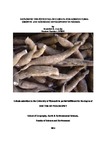Exploring the potential of cassava for agricultural growth and economic development in Nigeria
| dc.contributor.supervisor | Rahman, Sanzidur | |
| dc.contributor.author | Awerije, Brodrick | |
| dc.contributor.other | School of Geography, Earth & Environmental Sciences | en_US |
| dc.date.accessioned | 2014-08-13T09:06:13Z | |
| dc.date.available | 2014-08-13T09:06:13Z | |
| dc.date.issued | 2014 | |
| dc.date.issued | 2014 | |
| dc.identifier | 322825 | en_US |
| dc.identifier.uri | http://hdl.handle.net/10026.1/3082 | |
| dc.description.abstract |
The decline in agricultural productivity in Nigeria is linked to a host of factors ranging from unsustainable growth policies, inadequate funding and infrastructures, low levels of value added through processing, low commodity prices, unstable markets, poor extension services and low rates of literacy. It is now well recognised that there is a need to diversify Nigerian agriculture as well as improving production performances. This study investigates the potential of cassava root tuber (CRT), as a means to promote agricultural growth. It assesses cassava production, profitability, efficiency, marketing structures and channels, constraints in production, the potential to add value by processing cassava into gari (a fermented, roasted, and dried granule) and its marketing at the farm level. These were supplemented by a critical review of policies and programmes, including trend analysis of cultivated area, production, yield and prices of major crops including cassava at the national level covering the period 1970–2009. The study surveyed 315 cassava producers (including 278 gari processors), 105 marketers involved in cassava marketing and 30 stakeholders from three regions in the Delta State, Nigeria. Descriptive statistics are used to analyse the socio-economic characteristics of the sample. In addition, profitability of CRT and gari and their marketing were assessed by benefit-cost analysis. Furthermore, productivity and efficiency of CRT and gari and their determinants were analysed using non-parametric DEA followed by Tobit regressions. Results indicate that cassava production and processing is profitable in all regions and for all farm size categories. The BCR is estimated at 2.83 and 1.22 for CRT and gari, respectively. However, the yield level of CRT and gari is very low, estimated at 7.7 t/ha and 4.7 t/ha, respectively. Also, efficiency levels are very low and vary by farm size as well as regions, with large scale producers relatively more efficient. Marketing of cassava in any form is profitable and efficient (Marketing Efficiency>1 in all cases) and profitability varies widely across regions. Provision of water was identified as the main constraint in processing, followed by shortage of electricity and poor marketing infrastructure. The review of past policies and trend analysis revealed inconsistent policies and fluctuations in agricultural productivity, but also showed increases in total production mainly driven by expansion of the area cultivated during later years, for cassava in particular. The policy implications include: (a) increased provision of modern technologies, use of improved varieties and modern technology; (b) land reform policies to consolidate farm size; (c) investment in elements of marketing infrastructure; and (d) improvements in extension services. Despite inconsistencies in policies, cassava stood out as a robust and resistant crop which provides confidence that targeted investment in the cassava sector will contribute to development of Nigerian agriculture. | en_US |
| dc.description.sponsorship | Private/family | en_US |
| dc.language.iso | en | en_US |
| dc.publisher | Plymouth University | en_US |
| dc.subject | Production | |
| dc.subject | Productivity | |
| dc.subject | Gross Margins | |
| dc.subject | Profitability | |
| dc.subject | Efficiency | |
| dc.subject | Growth | |
| dc.subject | Development | |
| dc.subject | Agricultural | en_US |
| dc.title | Exploring the potential of cassava for agricultural growth and economic development in Nigeria | en_US |
| dc.type | Thesis | |
| plymouth.version | Full version | en_US |
| dc.identifier.doi | http://dx.doi.org/10.24382/4637 |
Files in this item
This item appears in the following Collection(s)
-
01 Research Theses Main Collection
Research Theses Main


